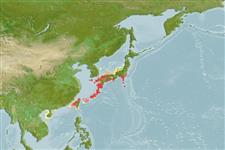Klassifizierung / Names
Namen | Synonyme | Catalog of Fishes(Gattung, Arten) | ITIS | CoL | WoRMS | Cloffa
>
Gobiiformes (Gobies) >
Gobiidae (Gobies) > Gobiinae
Etymology: Eviota: No etymology given, suggested by Christopher Scharpt: from Latin 'eu' for 'true' and 'iota' for anything very small, in combination 'truly very small' referring to it as being the smallest vertebrate at the time it has benn described by Jenkins (thus, making the suggestion by Scharpt plausible; rubrimaculata: Name as an adjective from the Latin 'rubra' for red and 'macula' for spot; referring to the
distinctive red spots on the head and body.
Environment: milieu / climate zone / depth range / distribution range
Ökologie
seewasser riff-verbunden; tiefenbereich 6 - 8 m (Ref. 104430). Subtropical
Verbreitung
Länder | FAO Gebiete | Ecosystems | Vorkommen | Point map | Einführungen | Faunafri
Northwest Pacific: Ryukyu Is., Japan.
Size / Gewicht / Alter
Maturity: Lm ? range ? - ? cm
Max length : 1.2 cm SL (female)
Kurzbeschreibung
Bestimmungsschlüssel | Morphologie | Morphometrie
Rückenflossenstacheln (insgesamt) : 7; Rückenflossenweichstrahlen (insgesamt) : 9; Afterflossenstacheln: 1; Afterflossenweichstrahlen: 8. This species is distinguished by the following characters: cephalic sensory-canal pore system pattern 2 (lacking only H [IT] pore); some pectoral-fin rays branched (11-15th rays); dorsal/anal fin-ray formula 9/8; absence of the 5th pelvic-fin ray; absence of the following - prominent distinct dark spots on pectoral-fin base, caudal-peduncle spot over preural centrum, postocular spots, and the strong and dark spots on caudal fin; anal-fin base with 2 dark spots; first dorsal fin clear with some light orange on anterodorsal portion and dark distal margin; second dorsal fin with red-orange spots on basal half, distal margin black and yellow; the body with bright red markings (Ref. 104430).
Life cycle and mating behavior
Geschlechtsreife | Fortpflanzung | Ablaichen | Eier | Fecundity | Larven
Suzuki, T., D.W. Greenfield and H. Motomura, 2015. Two new dwarfgobies (Teleostei: Gobiidae) from the Ryukyu Islands, Japan: Eviota flavipinnata and Eviota rubrimaculata. Zootaxa 4007(3):399-408. (Ref. 104430)
IUCN Rote Liste Status (Ref. 130435: Version 2024-1)
Bedrohung für Menschen
Harmless
Nutzung durch Menschen
Tools
Zusatzinformationen
Download XML
Internet Quellen
Estimates based on models
Phylogenetic diversity index (Ref.
82804): PD
50 = 0.5000 [Uniqueness, from 0.5 = low to 2.0 = high].
Bayesian length-weight: a=0.00692 (0.00284 - 0.01683), b=3.10 (2.92 - 3.28), in cm total length, based on LWR estimates for this Genus-body shape (Ref.
93245).
Trophic level (Ref.
69278): 2.9 ±0.3 se; based on size and trophs of closest relatives
Widerstandsfähigkeit (Ref.
120179): hoch, Verdopplung der Population dauert weniger als 15 Monate. (Preliminary K or Fecundity.).
Fishing Vulnerability (Ref.
59153): Low vulnerability (10 of 100).
